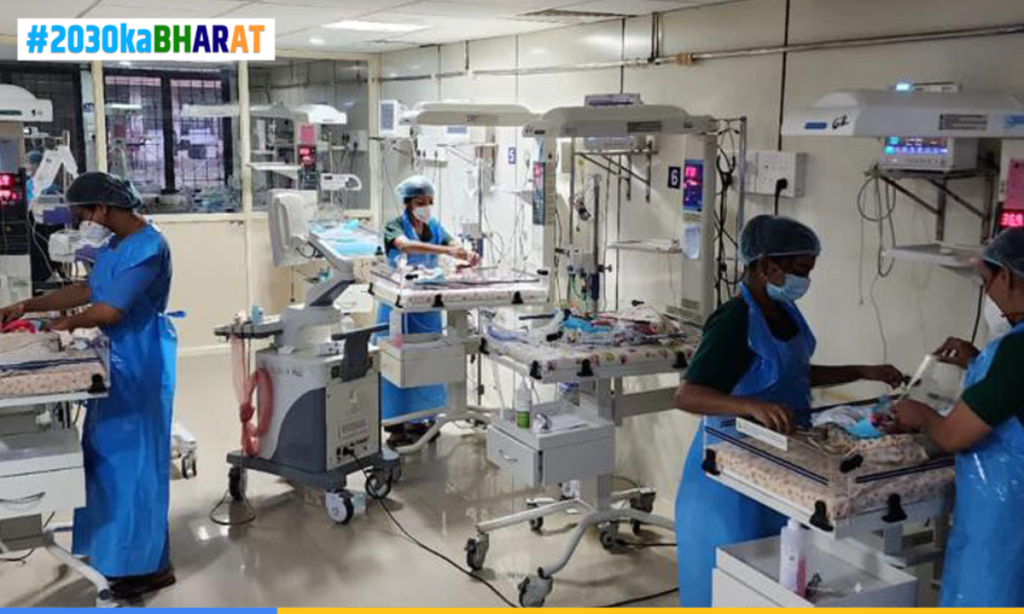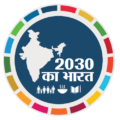I. Introduction of Good Health And Well-Being
In the pursuit of a sustainable future, the world has committed to the United Nations’ Sustainable Development Goals (SDGs), a universal call to action to end poverty, protect the planet, and ensure prosperity for all. Among the 17 goals, SDG 3 stands out, focusing on “Good Health and Well-being.” This article delves into India’s ambitious healthcare vision for 2030, with a central theme of achieving Universal Health Coverage (UHC) and its profound implications on the nation’s well-being.

II. Current Healthcare Landscape in India
Overview of India’s Healthcare System
India, as a populous and diverse nation, grapples with a complex healthcare landscape. The healthcare system comprises public and private sectors, with a significant urban-rural divide in access to medical facilities. Despite progress in recent years, healthcare indicators reveal persistent challenges, such as high maternal and child mortality rates.
Challenges and Disparities of Good health and well-being
Challenges in the healthcare sector are multifaceted. Limited access to primary healthcare in rural areas, inadequate infrastructure, and a shortage of healthcare professionals contribute to disparities. The National Health Profile (NHP) reports underscore these challenges, emphasizing the need for targeted interventions.
Key Health Indicators
India’s health indicators, including life expectancy, maternal mortality, and infectious diseases prevalence, paint a complex picture. For instance, the Maternal Mortality Ratio (MMR) remains high, impacting the overall good health and well-being of women. Addressing these indicators aligns with specific targets outlined in SDG 3.
III. Importance of Universal Health Coverage
Defining Universal Health Coverage (UHC)
UHC ensures that all individuals and communities receive essential health services without suffering financial hardship. It encompasses a spectrum of services, from preventive to curative, and promotes equitable access to healthcare resources.
Linking UHC to Good health and well-being
UHC is pivotal in achieving SDG 3 as it addresses the overarching goal of ensuring healthy lives and promoting well-being for all ages. By reducing health inequalities, UHC contributes to the overall social and economic development of a nation.
Benefits of Achieving UHC
The benefits of achieving UHC extend beyond health outcomes. Countries with robust UHC systems witness improved economic productivity, social cohesion, and resilience to public health crises. In India’s context, UHC promises a healthier and more productive population.

IV. Progress and Initiatives in India
Overview of India’s Progress Towards UHC
India has made significant strides in advancing UHC, with the National Health Mission (NHM) at the forefront. Launched in 2005, NHM aims to provide accessible, affordable, and quality healthcare, particularly to rural and vulnerable populations. The Ayushman Bharat initiative, encompassing the Pradhan Mantri Jan Arogya Yojana (PM-JAY), further underscores the commitment to UHC.
Government Initiatives and Policies
The Government of India has rolled out several initiatives to strengthen the healthcare infrastructure. PM-JAY, the world’s largest health insurance scheme, provides financial protection to vulnerable families. The Rashtriya Swasthya Bima Yojana (RSBY) and Janani Suraksha Yojana (JSY) are integral components of these efforts.
Success Stories and Case Studies
Examining successful implementation of healthcare initiatives provides valuable insights. Case studies from states like Kerala, which boasts exemplary health indicators, shed light on effective models for achieving UHC. These success stories demonstrate the transformative potential of targeted interventions.
1. Kerala’s Exemplary Health Model:
Background: Kerala, a state in southern India, has garnered international acclaim for its exemplary health indicators, often surpassing national averages. The success of Kerala’s health model is rooted in its commitment to providing accessible and comprehensive healthcare services.
Key Features:
- Comprehensive Primary Healthcare: Kerala has invested significantly in establishing and strengthening its primary healthcare system. This approach ensures that a broad spectrum of healthcare services is available at the grassroots level, promoting preventive and curative care.
- Focus on Social Determinants: Beyond the traditional healthcare paradigm, Kerala emphasizes addressing social determinants of health. Initiatives related to education, women’s empowerment, and poverty reduction have contributed to improved health outcomes.
Relevance: Examining Kerala’s health model offers valuable insights into the impact of a robust primary healthcare system and the integration of social determinants into health planning. This success story serves as an inspiration for other regions seeking to enhance their healthcare outcomes.
References:
- Kerala State Planning Board. (2019). “Kerala Economic Review 2018.” Retrieved from Kerala State Planning Board Publications

2. Ayushman Bharat – Pradhan Mantri Jan Arogya Yojana (PM-JAY):
Background: Ayushman Bharat – Pradhan Mantri Jan Arogya Yojana (PM-JAY) is a flagship healthcare initiative launched by the Government of India. It is recognized as the world’s largest health insurance scheme, aiming to provide financial protection to vulnerable families.
Key Features:
- Cashless Treatment: PM-JAY facilitates cashless treatment for beneficiaries, ensuring that eligible individuals can access a wide range of medical services without facing financial burdens.
- Beneficiary Targeting: The scheme identifies and targets economically vulnerable households, ensuring that those who are most in need receive the benefits of the program.
Relevance: Analyzing the implementation and impact of PM-JAY through case studies is critical for evaluating the effectiveness of large-scale health insurance programs in achieving the goal of Universal Health Coverage.
References:
- National Health Authority. (2021). “Ayushman Bharat – Pradhan Mantri Jan Arogya Yojana (PM-JAY): Operational Guidelines.” Retrieved from Ayushman Bharat – PM-JAY Guidelines

3. Digital Health Initiatives in Tamil Nadu:
Background: Tamil Nadu has emerged as a pioneer in the adoption of digital health solutions to enhance healthcare delivery. The state has integrated various technological interventions to overcome barriers to accessibility and improve health outcomes.
Key Features:
- Electronic Health Records (EHRs): Tamil Nadu’s implementation of EHRs has streamlined patient information management. This has led to better-coordinated care, improved patient outcomes, and enhanced efficiency in healthcare delivery.
- Telemedicine Services: The state has successfully integrated telemedicine services, particularly in rural areas. This addresses geographical barriers, enabling individuals in remote locations to access healthcare consultations and services.
Relevance: The case study of Tamil Nadu’s digital health initiatives illustrates how leveraging technology can contribute to overcoming challenges in healthcare accessibility and delivery.
References:
- Tamil Nadu Health Systems Project. (2019). “Tamil Nadu Health Systems Project – A Decade of Transformation.” Retrieved from Tamil Nadu Health Systems Project Reports
V. Challenges and Roadblocks
Persistent Challenges in Implementation
Despite progress, India faces challenges in implementing UHC. Insufficient investment in healthcare infrastructure, workforce shortages, and fragmented health information systems impede progress. The National Health Accounts (NHA) report highlights funding gaps that need urgent attention.
Socio-economic Factors and Healthcare Access
Socio-economic factors significantly influence healthcare access. Income inequality, education levels, and geographical location impact an individual’s ability to seek and receive medical care. Addressing these disparities requires a holistic approach that goes beyond the healthcare sector.
Regional Disparities and Their Impact
Regional disparities in healthcare outcomes are stark. Southern states often outperform their northern counterparts, indicating the need for region-specific strategies. A comprehensive analysis of the Annual Health Survey (AHS) data can guide targeted interventions in regions with the highest disparities.
VI. Partnerships and Collaborations
International Organizations’ Role
International organizations play a crucial role in supporting India’s healthcare goals. The World Health Organization (WHO) collaborates with India on various health programs, contributing technical expertise and financial resources. Leveraging global partnerships enhances India’s capacity to address complex health challenges.
Government-NGO-Private Sector Collaboration
Collaboration between the government, non-governmental organizations (NGOs), and the private sector is pivotal for sustainable healthcare development. Public-private partnerships (PPPs) can bridge gaps in service delivery, technology adoption, and resource mobilization. Successful models, such as the partnership between Tata Trusts and government initiatives, exemplify the potential of these collaborations.
Successful Partnerships: A Glimpse
Examining successful partnerships provides valuable insights. The collaboration between the Bill and Melinda Gates Foundation and the Indian government in the Polio Eradication Program serves as a model for effective disease control. Identifying and replicating such successful partnerships accelerates progress towards UHC.
VII. Future Strategies and Recommendations
Proposing Future Strategies
To realize the SDG 2030 Healthcare Vision, a roadmap with specific strategies is imperative. Increasing investment in healthcare infrastructure, enhancing human resource capacity, and leveraging technology for healthcare delivery are crucial components. Recommendations must align with the National Health Policy 2017 and the SDG framework.
Leveraging Technology for Advancements
Technology has the potential to revolutionize healthcare delivery. Telemedicine, electronic health records (EHRs), and artificial intelligence (AI) can enhance accessibility and efficiency. The Digital India initiative can be harnessed to accelerate the adoption of these technologies.
Advocacy for Increased Investments
A sustainable healthcare system necessitates increased investments. Advocacy for higher budget allocations, both at the national and state levels, is critical. The National Health Accounts (NHA) data can inform evidence-based advocacy efforts, ensuring that funding matches the scale of India’s healthcare challenges.

VIII. Conclusion
In conclusion, India stands at a critical juncture in its pursuit of SDG 2030 Healthcare Vision. Achieving Universal Health Coverage is not only a moral imperative but also a strategic investment in the nation’s future. By addressing persistent challenges, leveraging successful initiatives, and fostering collaborations, India can pave the way for a healthier and more prosperous society. The journey towards UHC requires unwavering commitment, innovation, and a collective effort from governments, civil society, and the private sector. As India charts its course, the world watches, hopeful that the vision of health for all will soon become a reality on the subcontinent.

